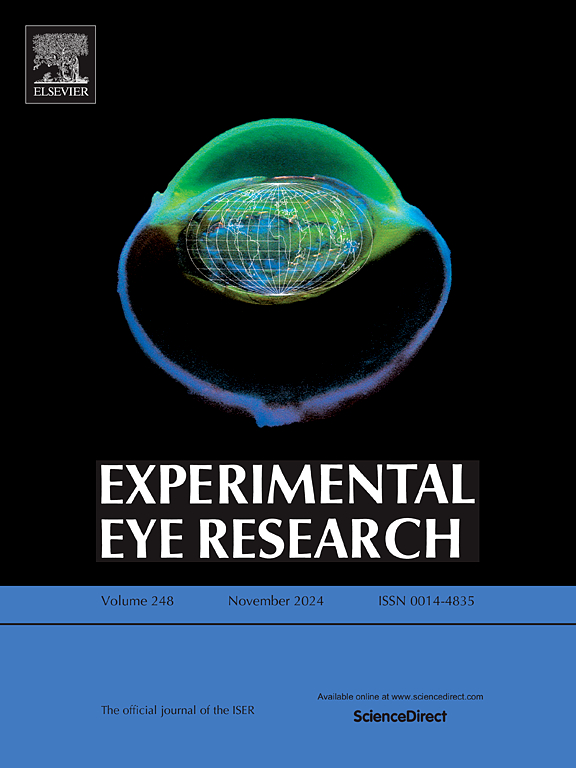METTL16 promotes corneal nerve regeneration in diabetic corneal neuropathy
IF 3
2区 医学
Q1 OPHTHALMOLOGY
引用次数: 0
Abstract
As a leading ocular disorder caused by diabetes mellitus, diabetic corneal neuropathy (DCN) is characterized by decreased corneal sensation, ocular irritation, delayed corneal wound healing and corneal neuropathic pain. Several researchers including us previously evidenced that DCN is regulated by several transcriptional and/or epigenetic factors. However, the role of N6-methyladenosine (m6A) modification, the most common internal modification in eukaryotic RNAs, in the pathogenesis of DCN remains largely unexplored. In the current work, we aimed to elucidate the pathological role of m6A modification in DCN. Using an m6A epitranscriptomic microarray, we identified differentially m6A-modified mRNAs in DCN. Additionally, we identified a significant decrease in the expression of methyltransferase-Like Protein 16 (METTL16) in trigeminal ganglion (TG) tissues of diabetic mice. Notably, using corneal epithelial nerve injury model and subconjunctival injection of adeno-associated virus, we demonstrated that activation of METTL16 promotes corneal nerve regeneration and accelerates corneal wound healing in DCN mice, suggesting the therapeutic potential of METTL16 in DCN. Moreover, by multi-omics approach, correlation analysis and experimental verification, we identified P4ha1, Pcm1, Ccnd1 and Hsph1 as potential targets of METTL16, revealing the molecular mechanism mediated by METTL16. We also observed a reduction in METTL16 levels in the peripheral blood of diabetic patients, indicating that METTL16 may serve as a potential biomarker for disorders associated with hyperglycemia. In light of these results, aberrant regulation of METTL16 may represent one of the pathogenic mechanisms underlying DCN and could serve as a potential therapeutic target for its treatment.
METTL16促进糖尿病角膜神经病变角膜神经再生。
糖尿病性角膜神经病变(diabetic corneal neuropathy, DCN)是糖尿病引起的主要眼部疾病,其特点是角膜感觉下降、眼部刺激、角膜创面愈合延迟和角膜神经性疼痛。包括我们在内的几位研究人员先前证明DCN受几种转录和/或表观遗传因素的调节。然而,真核rna中最常见的内部修饰n6 -甲基腺苷(m6A)修饰在DCN发病机制中的作用在很大程度上仍未被探索。在目前的工作中,我们旨在阐明m6A修饰在DCN中的病理作用。使用m6A表转录组芯片,我们鉴定了DCN中不同的m6A修饰mrna。此外,我们发现糖尿病小鼠三叉神经节(TG)组织中甲基转移酶样蛋白16 (METTL16)的表达显著降低。值得注意的是,通过角膜上皮神经损伤模型和结膜下注射腺相关病毒,我们证明了METTL16的激活促进了DCN小鼠角膜神经再生,加速了角膜伤口愈合,这表明METTL16在DCN中的治疗潜力。此外,通过多组学、相关分析和实验验证,我们发现P4ha1、Pcm1、Ccnd1和Hsph1是METTL16的潜在靶点,揭示了METTL16介导的分子机制。我们还观察到糖尿病患者外周血中METTL16水平的降低,表明METTL16可能作为与高血糖相关疾病的潜在生物标志物。根据这些结果,METTL16的异常调控可能代表了DCN的致病机制之一,并可能作为其治疗的潜在治疗靶点。
本文章由计算机程序翻译,如有差异,请以英文原文为准。
求助全文
约1分钟内获得全文
求助全文
来源期刊

Experimental eye research
医学-眼科学
CiteScore
6.80
自引率
5.90%
发文量
323
审稿时长
66 days
期刊介绍:
The primary goal of Experimental Eye Research is to publish original research papers on all aspects of experimental biology of the eye and ocular tissues that seek to define the mechanisms of normal function and/or disease. Studies of ocular tissues that encompass the disciplines of cell biology, developmental biology, genetics, molecular biology, physiology, biochemistry, biophysics, immunology or microbiology are most welcomed. Manuscripts that are purely clinical or in a surgical area of ophthalmology are not appropriate for submission to Experimental Eye Research and if received will be returned without review.
 求助内容:
求助内容: 应助结果提醒方式:
应助结果提醒方式:


